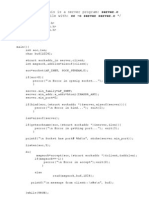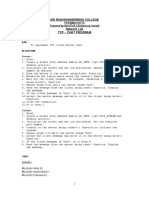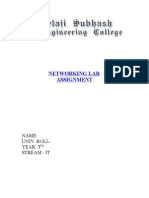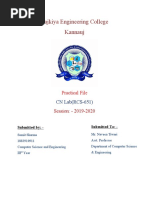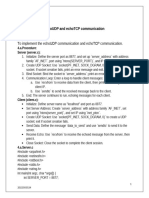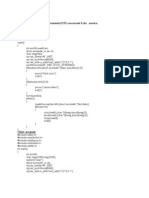Dns Application
Dns Application
Uploaded by
jsksaranCopyright:
Available Formats
Dns Application
Dns Application
Uploaded by
jsksaranOriginal Title
Copyright
Available Formats
Share this document
Did you find this document useful?
Is this content inappropriate?
Copyright:
Available Formats
Dns Application
Dns Application
Uploaded by
jsksaranCopyright:
Available Formats
DNS APPLICATION AIM: To write a program to develop an application for DNS. ALGORITHM: Server: 1. Include required header files.
2. Create a socket between server and client. 3. Bind server to socket. 4. Listen to the message from the client. 5. Accept the message from the client. 6. Display the host name. 7. resolve the host name. 8. Display the output and send it to client. Client: 1. Include required header files. 2. Define the port family. 3. Create socket using SOCKET(). 4. Connect the client to the socket using CONNECT(). 5. Enter the host name and send it to server. 6. The result is received and displayed .
PROGRAM: Server: #include<stdio.h> #include<sys/socket.h> #include<sys/types.h> #include<arpa/inet.h> #include<unistd.h> #include<netdb.h> #include<string.h> #include<stdlib.h> #define SER_PORT 8765 int main() { int a,c; FILE *f1,*f2; int sersock,newsock,n; char str[25],str2[25],host[25]; void *buf1,*buf2; struct sockaddr_in servaddr,clinfo; struct hostent *hp; socklen_t size=sizeof(clinfo); servaddr.sin_family=AF_INET; servaddr.sin_port=htons(SER_PORT); servaddr.sin_addr.s_addr=htonl(INADDR_ANY); if((sersock=socket(AF_INET,SOCK_STREAM,0))<0) { error("Socket!\n"); exit(0); } if(bind(sersock,(struct sockaddr*)&servaddr,sizeof(servaddr))<0) { error("Bind!\n"); exit(0); } if(listen(sersock,1)<0) { error("Listen!\n"); exit(0); } size=sizeof(clinfo);
if((newsock=accept(sersock,(struct sockaddr*)&clinfo,&size))<0) { error("Accept!\n"); exit(0); } else printf("Connected to %s\n",inet_ntoa(clinfo.sin_addr)); read(newsock,host,sizeof(host)); printf("%s",host); hp=gethostbyname(host); inet_ntop(AF_INET,hp->h_addr,str2,sizeof(str2)); printf("%s",str2); write(newsock,str2,strlen(str2)+1); close(newsock); close(sersock); return 0; }
Client: #include<stdio.h> #include<sys/socket.h> #include<sys/types.h> #include<arpa/inet.h> #include<netdb.h> #include<netinet/in.h> #include<unistd.h> #include<stdlib.h> #include<string.h> #define SER_PORT 8765 int main(int count,char *argv[]) { int a; int clisock,x,b,c; char str[25],host[25]; char str2[25]; struct sockaddr_in cliaddr; cliaddr.sin_port=htons(SER_PORT); cliaddr.sin_family=AF_INET; cliaddr.sin_addr.s_addr=inet_addr(argv[1]); clisock=socket(AF_INET,SOCK_STREAM,0); if(clisock<0) { perror("No Socket!\n"); exit(0); } if((x=connect(clisock,(struct sockaddr*)&cliaddr,sizeof(cliaddr)))<0) { perror("No connect!\n"); exit(0); } printf("Enter Domain Name: "); scanf("%s",host); write(clisock,host,strlen(host)+1); read(clisock,str2,sizeof(str2)); printf("%s\n",str2); close(clisock); return 0; }
OUTPUT: Server: [test2@localhost ~]$ vi dnsserv.c [test2@localhost ~]$ cc dnsserv.c [test2@localhost ~]$ ./a.out Client: [test2@localhost ~]$ vi dnscli.c [test2@localhost ~]$ cc dnscli.c [test2@localhost ~]$ ./a.out 192.160.10.2 Enter Domain Name: localhost 127.0.0.1 Server: Connected to 193.167.1.225 localhost127.0.0.1
RESULT: Thus the above program DNS application was completed successfully.
You might also like
- Unix LAB MANUALDocument53 pagesUnix LAB MANUALRahul AnandNo ratings yet
- Network Lab ManualDocument32 pagesNetwork Lab ManualPraburadhaNo ratings yet
- Becse 23241 G1 20105131 A3Document20 pagesBecse 23241 G1 20105131 A3bt2O1O5131 AnshulNo ratings yet
- Unix Programming LabDocument52 pagesUnix Programming LabNithishNo ratings yet
- Network LabDocument16 pagesNetwork LababhijeetNo ratings yet
- Computer Network FileDocument17 pagesComputer Network FileAviral ChaurasiaNo ratings yet
- Lab3 CN1Document5 pagesLab3 CN1Diksha NasaNo ratings yet
- Ilovepdf MergedDocument73 pagesIlovepdf Mergedmohamedrasheed.ahamed2021No ratings yet
- L1F21BSCS0463 Lab6Document9 pagesL1F21BSCS0463 Lab6bakhtawarmehmeenNo ratings yet
- Network Programming Lab: Submit by Guided byDocument28 pagesNetwork Programming Lab: Submit by Guided byJámès KõstãNo ratings yet
- Implementation of Client Side and Server Side Program With Command Line Arguments For Connection Less Socket Using CDocument15 pagesImplementation of Client Side and Server Side Program With Command Line Arguments For Connection Less Socket Using CachintasatNo ratings yet
- Client Server ProgramDocument2 pagesClient Server ProgramRohit LalNo ratings yet
- Lab ManualDocument28 pagesLab ManualSanika MoreNo ratings yet
- Client-Server Communication With One Client and One ServerDocument6 pagesClient-Server Communication With One Client and One ServerRishabh ShrivasNo ratings yet
- Network Lab by ArmstrongDocument52 pagesNetwork Lab by Armstrongarmstrongjoseph1908No ratings yet
- 2021UCP1387_CN_Assign-1Document10 pages2021UCP1387_CN_Assign-12021ucp1377No ratings yet
- Networking Lab Assignment: Name: Univ. Roll: Year: 3 Stream: ItDocument14 pagesNetworking Lab Assignment: Name: Univ. Roll: Year: 3 Stream: ItBaidyanath DuttaNo ratings yet
- Networking LabDocument68 pagesNetworking LabRam Kumar100% (1)
- CN Assignment 20105034 Saksham GargDocument19 pagesCN Assignment 20105034 Saksham GargSamuel GarryNo ratings yet
- Cs9216 Networking LabDocument72 pagesCs9216 Networking Labkvkayal9054No ratings yet
- UDP Client/Server Communication Aim: Procedure: Server (Server.c)Document4 pagesUDP Client/Server Communication Aim: Procedure: Server (Server.c)Tejesshree.SNo ratings yet
- 21bai1660 Bcse308p Assignment3 HrishikeshgkDocument6 pages21bai1660 Bcse308p Assignment3 HrishikeshgkDebu SinghNo ratings yet
- What Is Socket ProgrammingDocument7 pagesWhat Is Socket Programmingchowsaj9No ratings yet
- Stop and WaitDocument4 pagesStop and WaitJobin LuckoseNo ratings yet
- Rajkiya Engineering College Kannauj: Practical FileDocument17 pagesRajkiya Engineering College Kannauj: Practical FilesumitNo ratings yet
- 22BD1A05DD-CN-TCP TRANSFERDocument7 pages22BD1A05DD-CN-TCP TRANSFERsampreethip638No ratings yet
- TCP Client/Server Communication Aim: Procedure: Server (Server.c)Document4 pagesTCP Client/Server Communication Aim: Procedure: Server (Server.c)Tejesshree.SNo ratings yet
- Sample UDP ImplementationDocument4 pagesSample UDP ImplementationShilpa DasNo ratings yet
- Expt8 CNDocument9 pagesExpt8 CNShivendraraje PolNo ratings yet
- What Is A SocketDocument8 pagesWhat Is A SocketNag ReddyNo ratings yet
- Practica1 TecnoDocument8 pagesPractica1 TecnoUlrich Matthew Vidangos PhilippsbergNo ratings yet
- Socket - Exceuted UbantuDocument9 pagesSocket - Exceuted Ubantushreekar.nyayapathi23No ratings yet
- UDP CLIENtDocument7 pagesUDP CLIENt118 Borude Omkar KarbhariNo ratings yet
- CN Assignment5 SiddharthDocument4 pagesCN Assignment5 SiddharthKunj BhansaliNo ratings yet
- Sem Unp Lab ProgramsDocument39 pagesSem Unp Lab ProgramsEnduku MeekuNo ratings yet
- Echo UDPDocument12 pagesEcho UDPTejesshree.SNo ratings yet
- 1program To Implement Connection Oriented Server (TCP Server)Document29 pages1program To Implement Connection Oriented Server (TCP Server)Shireesha KulkarniNo ratings yet
- Experimentthings MergedDocument28 pagesExperimentthings MergedManoj RouthuNo ratings yet
- NETWORKRECORDDocument14 pagesNETWORKRECORDSruthi RajendranNo ratings yet
- TCP Program Client and ServerDocument5 pagesTCP Program Client and ServerssnitanuNo ratings yet
- CNS Assignment 3Document9 pagesCNS Assignment 3DaminiNo ratings yet
- 22BD1A05DD-CN-TCP ReverseDocument5 pages22BD1A05DD-CN-TCP Reversesampreethip638No ratings yet
- File Transfer TCP Algorithm: Program 6Document13 pagesFile Transfer TCP Algorithm: Program 6sara aliNo ratings yet
- Socket ProgrammingDocument13 pagesSocket Programminguzairch514No ratings yet
- Computer Networks SWE2002 Digital Assignment - 1: Name: REG. NO: 18MIS0083Document9 pagesComputer Networks SWE2002 Digital Assignment - 1: Name: REG. NO: 18MIS0083Challa Obula Naidu 18MIS0083No ratings yet
- Quest 3Document22 pagesQuest 3Garvit ChauhanNo ratings yet
- CN Lab ExercisesDocument15 pagesCN Lab ExercisesPiyush VijayNo ratings yet
- School of Information Technology and EngineeringDocument7 pagesSchool of Information Technology and EngineeringGarvit KatariaNo ratings yet
- Lab QuizDocument4 pagesLab Quizyashu1234577No ratings yet
- COE 4DN4 Lab1: DNS-Domain Name ServerDocument10 pagesCOE 4DN4 Lab1: DNS-Domain Name ServerRohan ThivyNo ratings yet
- AIM: Implement Connection Oriented (TCP) Concurrent Echo Service. Server ProgramDocument39 pagesAIM: Implement Connection Oriented (TCP) Concurrent Echo Service. Server Programsantosh.parsaNo ratings yet
- Koushikcrypto5lab CompressedDocument20 pagesKoushikcrypto5lab CompressedKatta koushik reddyNo ratings yet
- The Port Client Will Be Connecting To // Max Number of Bytes We Can Get at OnceDocument4 pagesThe Port Client Will Be Connecting To // Max Number of Bytes We Can Get at OnceJayakrishna IJNo ratings yet
- BÁO CÁO LẬP TRÌNH ỨNG DỤNGDocument7 pagesBÁO CÁO LẬP TRÌNH ỨNG DỤNGsaomai123464No ratings yet
- Lab 4 - TCP - Ip - Sum - Two - Numbers - 20mis1115Document6 pagesLab 4 - TCP - Ip - Sum - Two - Numbers - 20mis1115SamNo ratings yet
- File TransferDocument4 pagesFile Transfersathul257No ratings yet
- Structuri Socket TCPDocument2 pagesStructuri Socket TCPWisclaw DaniNo ratings yet
- 22013570039Document35 pages22013570039gandhiradhikaNo ratings yet
- TCP Socket CreationDocument8 pagesTCP Socket CreationsriNo ratings yet
- Understanding Software Engineering Vol 3: Programming Basic Software Functionalities.From EverandUnderstanding Software Engineering Vol 3: Programming Basic Software Functionalities.No ratings yet











